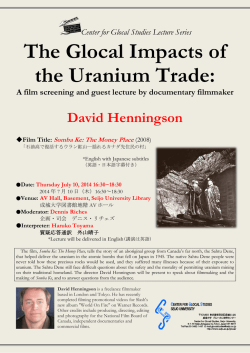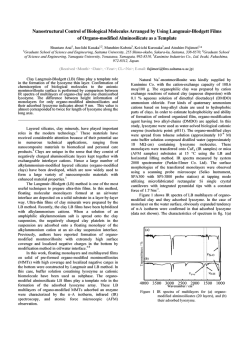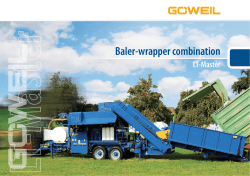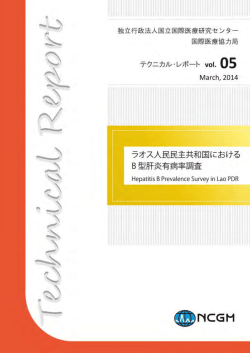
Development of Crystallization of PZT Films by Laser
レーザアニールによるPZT薄膜の結晶化技術の開発 Development of Crystallization of PZT Films by Laser Annealing 陳 顕鋒* 八木 Xianfeng CHEN 雅広* Masahiro YAGI 要 旨 _________________________________________________ ゾルゲル法で作製したチタン酸ジルコン酸鉛(PZT)アモルファス膜を,波長980nm半導 体レーザで下部電極の白金(Pt)部を加熱して結晶化させることを我々は討議した.膜の比 誘電率測定により1回のレーザアニール処理で厚さ45nmのPZT結晶膜を形成できることが分 かった.このため,毎回塗布した膜の厚みを45nm以下に抑え,かつレーザアニールパワー を制御することで,厚さ150nmPZT結晶膜を4回繰返して成膜した.得られたPZT膜の比誘電 率は1,200,圧電定数は従来のラピッドサーマルアニール(RTA)法で結晶化したPZT膜と同 等レベルを達成した. ABSTRACT _________________________________________________ Crystallization of Pb(Zr0.53Ti0.47)O3 (PZT) films, derived from PZT sol-gel solutions, using a continuous-wave (CW) 980 nm semiconductor laser is discussed in this paper. From dielectric constant measurement, it is found that one laser annealing (LA) process generates 45-nm-thick crystallized PZT layer. By using 0.3 M precursor solution and repeating 4 times the LA processes, 150-nm-thick crystallized PZT films are obtained with (111)-preferred texture. By adjusting the laser power for each annealing process, PZT crystallization is formed in the entire film, which is confirmed by electron diffraction patterns. The dielectric constant of the PZT film is about 1200. Its longitude piezoelectric constant (d33), measured by an atomic force micscopy, is comparable to that of PZT film fabricated by rapid thermal annealing. * GJ開発本部 GC開発センター GC Development Center, GJ Design & Development Division Ricoh Technical Report No.39 133 JANUARY, 2014 1. 2. Introduction Experimental Pb(Zr0.53Ti0.47)O3 (PZT) has excellent piezoelectric The laser used for the annealing treatment is a 980 nm properties and is extensively used in various devices, continuous-wave (CW) semiconductor laser. It has a including print heads of inkjet printers. PZT films can be maximum output power of 300 W. Part of the laser fabricated by sol-gel (SG) deposition, sputtering, and so annealing system is shown in Fig.1. The laser irradiation forth. Compared with other methods, SG method offers beam is modified to a rectangular shape (1000 X 350 several advantages, such as precise stoichiometry control, m2) with a flat-top intensity profile. low cost, and large surface coverage. Therefore, it is widely adopted in PZT industrial fabrication. Optical system 350um thermal annealing process is necessary. It is generally 1000um To crystallize PZT films derived from SG solution, a X-Y stage carried out by heating up the sample to about 750 oC in a Laser beam rapid thermal annealing (RTA) apparatus, where almost all heat energy is used to raise and lower the temperature of the substrate and the apparatus body, resulting in Fig.1 Laser annealing system used in the experiment. significant waste of heat energy and run time. Laser annealing (LA) is an efficient annealing technique that it Two kinds of PZT SG solutions synthesized in a 2- can only heat the wanted areas by selecting right methoxyethanol based route are used in the experiment. wavelength and has been used in manufacture of solar The solutions have the same composition, where Zr/Ti cells and power devices. ratio is 53/47 and Pb excess is 10.8%, but they have Many researchers have attempted to apply this different technique to PZT crystallization since three decades concentrations. One solution has a concentration of 0.5 M, and the other has a concentration ago1-7). To date, only Baba et al.6), who used a CO2 laser, of 0.3 M. The 0.5 M solution was used to calculate the and Bharadwaja et al.7), who used an excimer laser, possible thickness of crystallized PZT by one LA process, reported that they obtained crystallized LA-PZT films as the 0.3 M solution was used to generate well-crystallized good as RTA-treated ones. However, in these cases, PZT films. particular amorphous PZT films were preformed. A flow chart of the LA process is shown in Fig.2. Considering productivity, a semiconductor diode laser After spin-coating the PZT precursor solution on a Pt- is preferred because of its low cost, small size, and low metalized Si substrate at a speed of 3000 rpm for 20 s, energy consumption, compared with conventional solid the wafer was dried at 120 oC for 1 min and pyrolyzed at state, CO2 or excimer lasers. In this paper, we provide a a temperature of 200 oC for 1 min to form amorphous method that can be used to crystallize PZT films derived PZT. Then, LA treatment was carried out at room from SG solution on Pt-metalized Si substrate by LA temperature in an atmospheric environment by setting treatment. Characteristics of the LA-PZT films are also the wafer on an X-Y stage and scanning the laser beam reported. on the wafer surface along the 350 m side at a speed of 10 mm/s. To get thick PZT films, this process is repeated, until the desired thickness is achieved. Ricoh Technical Report No.39 134 JANUARY, 2014 Spin coating (3000rpm, 20s) with a (111)-preferred orientation. For the RTA process, Drying (120oC, 1min) the transient intermediate layer formed on Pt at the initial it is usually argued that the PZT texture is determined by annealing stage8-10). However, it is also considered that Repetition the strain generated in the PZT film affects its Pyrolysis (200oC, 1min) texture11,12). As the LA treatment is different from the RTA treatment and has only millisecond-order duration, LA treatment the crystallization mechanism is not clear yet. Fig.2 Flow chart of the LA process. Intensity (arb. unit) After that, a Pt upper electrode of 200 m diameter was sputter-deposited in the LA-PZT area through a shadow mask to evaluate the electrical properties. X-ray diffraction (XRD; PANalytical X’Pert Pro) and transmission electron microscopy (TEM; Hitachi N- Pt(111) PZT(111) 9000NAR) were carried out to assess the crystal characteristics of LA-PZT films. The dielectric constant 20 and loss tangent were measured using an impedance 30 2θ(deg) 40 50 analyzer (HP4194A). The field-induced strain properties Fig.3 were evaluated using a ferroelectric test system (Toyo XRD pattern of a double layer LA-PZT film. Technica FCE-1) and an atomic force microscopy (AFM; SPA-400) equipment. To determine the thickness of crystallized PZT film by one LA treatment, a two-layer PZT sample is prepared. 3. Its schematic structure is shown in Fig.4. LA treatment Results and Discussion was only performed to part of the first layer. The thickness of the areas with (Fig.4 (a)) and without (Fig.4 Since the photon energy of the 980 nm laser is much (b)) LA treatment are 125 and 132 nm, respectively. The less than the band gap energy of PZT, the laser energy thickness difference is considered to be caused by the will be mainly absorbed by the Pt lower electrode and shrinkage of the PZT film, when it is changed from converted to heat there, but little in PZT films. Therefore, amorphous to crystalline phase. Since heat is generated when the thickness of PZT films is changed, the in the Pt lower electrode, PZT crystallization is estimated scanning laser output power has to be adjusted to keep to start near it and then extends to the upper part. the heat generation rate in the Pt films at a certain value. Fig.3 shows the XRD pattern of a LA-PZT sample derived from the 0.5 M PZT precursor solution by repeating 2 times the LA processes on a Pt(111)/Si substrate. The laser powers used for the first and second LA treatments are 55 and 100 W, respectively. The XRD pattern reveals that the amorphous PZT was crystallized Ricoh Technical Report No.39 135 JANUARY, 2014 Pt PZT Amorphou PZT s Crystallized (a) (b) 50nm C’_amor C_amor Fig.5 C’_cryst (c) Fig.4 Pt C_amor Cross-sectional dark filed TEM image of the 150-nm-thick LA-PZT film. (d) The displacement-voltage (-V) results measured by Schematic structure of a two-layer PZT film. the AFM method at a driving frequency of 3 Hz are shown in Fig.6. For the LA-PZT, Fig.6 (a) shows that The measured dielectric constant (osc = 0.8 V at 10 kHz) of PZT in Fig.4 (a) is 80, while that in Fig.4 (b) is calculated longitudinal piezoelectric constant (d33) in 50. As the dielectric constant of the crystallized PZT is positive sweep loop (d33+) is 61 pm/V and that in the assumed to be 130013), using the models shown in Figs.4 negative sweep loop (d33-) is 113 pm/V. A RTA-PZT (c) and (d), it can be calculated that the thickness of the sample was also measured by the same form. The result crystallized PZT layer in Fig.4 (a) is about 45 nm. Thus, is shown in Fig.6 (b), where its d33+ and d33- are 60 and 101 pm/V, respectively. The AFM evaluation suggests reducing the thickness of each deposited PZT layer is a possible method of fabricating well-crystallized thick that the LA-PZT film has piezoelectric properties PZT films by the LA treatment. comparable to those of the RTA-PZT film. The poor A 150-nm-thick PZT film was obtained by using 0.3 appearance of the -V curves of LA-PZT might result M SG solution and repeating 4 times the LA processes. from the thin film thickness. Because the absolute The laser power was adjusted for each LA process. A displacement is small, noise interference is relatively larger. Especially, when the driving voltage is near to 0, cross-sectional dark field TEM image of the sample is the displacement is too small to be detected correctly. shown in Fig.5. Although it is a four-layer sample, the interface lines are not clear. This is attributed to the low pyrolysis temperature used in the LA process and short annealing duration, which prevented the Pb evaporation. The inserted figure shows an electron diffraction pattern of the PZT film. The incident electron beam is about 100 nm in diameter, which is close to the PZT film thickness. Thus, the ordered dot-pattern indicates that the entire film is well crystallized. The measured dielectric constant of the LA-PZT film, which is about 1200, can also demonstrate it. Ricoh Technical Report No.39 136 JANUARY, 2014 1000 Acknowledgements__________________________ (a) d33- The authors would like to than Professor H. Funakubo Displacement (pm) 800 of Tokyo Institute of Technology for the measurement of 600 d33+ the piezoelectric constant. 400 200 References ________________________________ 1) 0 -10 -5 0 5 10 ferroelectric-phase PbTiO3 thin films, J. Appl. Phys., -200 Voltage (V) Vol.52, pp.5107-5111 (1981). 2) 2500 Appl. Phys. Lett., Vol.66, pp.2481-2483 (1995). Displacement (pm) 2000 d33+ 1500 X. M. Lu, et al.: Pulsed excimer (KrF) laser induced crystallization of PbZr0.44Ti0.56O3 amorphous films, (b) d33- 3) P. P. Donohue and M. A. Todd: Pulse-extended excimer laser annealing of lead zirconate titanate 1000 thin 500 -20 -10 films, Integrated Ferroelectrics, Vol.31, pp.285-296 (2000). 4) 0 -30 0 10 20 30 H. –C. Pan, et al.: Low-temperature processing of sol-gel derived La0.5Sr0.5MnO3 buffer electrode and -500 Voltage (V) Fig.6 Y. Matsui, et al.: Laser annealing to produce PbZr0.52Ti0.48O3 films using CO2 laser annealing, Appl. Phys. Lett., Vol.83, pp.3156-3158 (2003). Displacement-voltage behaviors of (a) LA-PZT and (b) RTA-PZT films. 5) S. C. Lai, et al.: Extended-pulse excimer laser annealing of Pb(Zr1-xTix)O3 thin film on LaNiO3 4. electrode, J. Appl. Phys., Vol.96, pp.2779-2784 Conclusions (2004). 6) Using a 980 nm CW semiconductor laser, we have S. Baba, et al.: Effect of carrier gas species on ferroelectric properties of PZT/Stainless-Steel developed PZT films in an atmospheric environment. By fabricated by CO2 laser-assisted aerosol deposition, controlling thickness of each deposition layer and J. Am. Ceram. Soc., Vol.89, pp.1736-1738 (2006). adjusting the corresponding laser output power, well- 7) S. S. N. Bharadwaja, et al.: Highly textured laser crystallized 150-nm-thick LA-PZT films are obtained. annealed Pb(Zr0.52Ti0.48)O3 thin films, Appl. Phys. The films show good piezoelectric properties comparable Lett., Vol.99, 042903 (2011). to those of RTA-PZT films. The LA process could save 8) T. schneller, et al.: Investigation of the amorphous not only the energy but also the process time. In addition, to crystalline phase transition of chemical solution together with the inkjet printing (IJP) technique, which deposited Pb(Zr0.3Ti0.7)O3 thin films by soft X-ray could eject droplets of PZT SG solution in selected absorption and soft X-ray emission spectroscopy, J. areas14), Sol-Gel Sci. Technol., Vol.48, pp.239-252 (2008). the LA technique can easily integrate piezoelectric devices with others and is expected to open a new filed of PZT application. Ricoh Technical Report No.39 137 JANUARY, 2014 9) U. Ellerkmann, et al.: Reduction of film thickness for chemical solution deposited PbZr0.3Ti0.7O3 thin films revealing no size effects and maintaining high remanent polarization and low coercive field, Thin Solid Films, Vol.516, pp.4713-4719 (2008). 10) S. Y. Chen and I. W. Chen, Temperature-time texture transition of Pb(Zr1-xTix)O3 thin films: I, Role of Pb-rich intermediate phases, J. Am. Ceram. Soc., Vol.77, pp.2332-2336 (1994). 11) S. Y. Chen and I. W. Chen, Texture development, microstructure evolution, and crystallization of chemically derived PZT thin films, J. Am. Ceram. Soc., Vol.81, pp.97-105 (1998). 12) J. H. Lee, et al.: Microstress relaxation effect of Pb(Zr0.52Ti0.48)O3 films with thickness for micro/nanopiezoelectric device, Appl. Phys. Lett., Vol.96, 092904 (2010). 13) T. Ijima, et al.: Synthesis of 10-m-thick lead zirconate titanate films on 2-in. Si substrates for piezoelectric film devices, Int. J. Appl. Ceram. Technol., Vol.3, pp.442-447 (2006). 14) O. Machida, et al.: Fabrication of lead zirconate titanate films by inkjet printing, Jpn. J. Appl. Phys., Vol.51, 09LA11 (2012). Ricoh Technical Report No.39 138 JANUARY, 2014
© Copyright 2024



